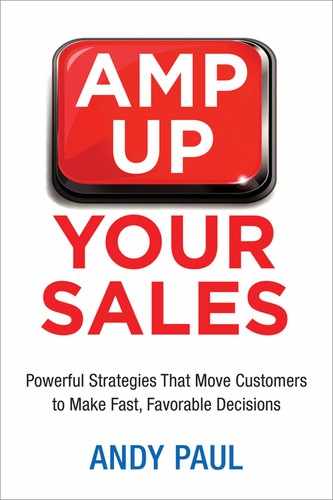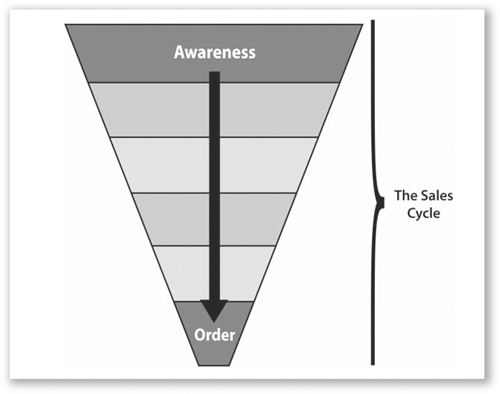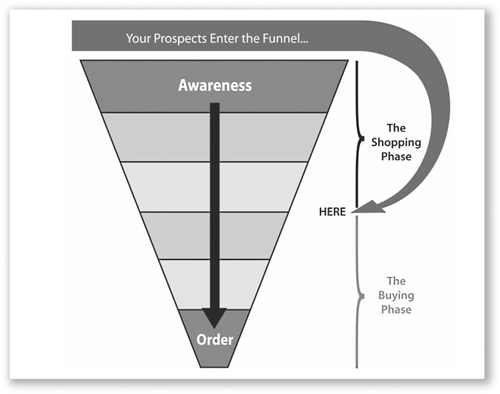CHAPTER 11
The New Sales Funnel
We’re all familiar with the sales funnel. It’s a commonly used metaphor for moving prospects through the stages of your sales process. The funnel was once a useful tool to manage prospective customers, but customers and their buying behaviors have been so significantly transformed over the past 15–20 years that the old sales funnel has become obsolete.
In its place is a New Sales Funnel that more accurately reflects how customers are moving through the stages of their buying processes. But, even more crucially, the New Sales Funnel reflects changes in how your customers need you to sell to them. And at the center of this change are the concept and practice of responsiveness.
In his bestselling book, Talent Is Overrated, Geoffrey Colvin shined the spotlight on the major challenge for decision makers. He said, “Getting information pushes at the two constraints everyone faces: it takes time and costs money. Making sound decisions fast and at a low cost is a competitive advantage everywhere.”
In other words, how customers make a decision becomes a competitive business advantage for them. In Chapter 2, you learned that how you sell creates tangible differentiation that provides a true competitive sales advantage for you, the seller. Taken together, this means you can solidify your competitive sales advantage by selling in a manner that makes it faster and easier for the customer to make a decision.
Your customers need you to become a responsive seller by providing them the information they need to make an informed decision in the least time possible. If you can tightly align your selling process with their information needs, you’ll be able gain the competitive advantage described by Colvin.
What are your customers’ costs of getting information? Primarily, it’s the time and cost of the people involved in the process. Think back to Chapter 6. What is the one item that will always be in short supply for your prospects? Time. Customers are always short on time and have to be careful about investing it wisely. For your customers to earn a good ROTI, you have to practice absolute responsiveness. Every minute customers spend on gathering information in their buying process is a minute they can’t spend on other profit-making activities. If you make it time-consuming or difficult for customers to get the information they need, you’re impeding their ability to compete in their own markets.
Responsiveness is becoming increasingly important to your ability to win business from your customers. For example, let’s say there are two sellers, AmpCo and SLO Inc., competing for a big order from DLP Industries. AmpCo’s disciplined, rapid sales process provides the information DLP Industries needs at each step of its buying process to make a well-informed and fast purchasing decision. SLO Inc. isn’t as organized in its selling processes, with customer requests for information sometimes going unanswered for more than a day or two. Who’s more likely to win the business? This focus on responsiveness leads us back to the sales funnel—or what I call the New Sales Funnel.
We all recognize the classic shape of a funnel. In real life, or at least in life outside of sales, funnels are used to transfer liquids from one container to another without spilling. In selling, funnels are meant to transfer potential customers from one stage of the selling process (an interested buyer) to another (a paying customer) without losing them.
The old sales funnel had four distinguishing features, as shown in Figure 11-1. First, there is the broad wide opening at the top to accept all the prospects and suspects that marketing or sales want to throw in there. The second feature is the stages of the selling process that winnow down the number of active prospects. Each of the designated stages is meant to represent a milestone on the path to getting an order. As we continue our way down the funnel, we come to the third feature, the narrow neck and small opening at the bottom, representing the exit path for the fraction of prospects that become customers.
The fourth distinguishing feature of the funnel is the most important to you, and that’s the way the water backs up to the brim as you pour it in and you wait for it to drain out the bottom of the funnel. That’s what happens to most prospects today when they enter the funnel. They wait for a salesperson to respond. Back in the pre-Internet days, waiting was about the only option customers had. If they wanted information about the product or service you were selling, they had to come to you because you were pretty much the sole source of information about those products. But that has all changed.
Today, everyone is familiar with how prospects are largely pre-educated about products and services before they engage with a salesperson for the first time. Studies estimate that in the B2B space, the typical prospects are anywhere from 50 to 75 percent of the way through their buying process before they engage with a seller. They pore over the content on the seller’s website, ask questions within their social networks, find user comments and reviews online, participate in LinkedIn discussion groups, and talk with peers on industry forums. This is what I call the Shopping Phase of the buying process. They are searching for and making use of all publicly available information to move as far as possible through the buying process without involving a salesperson.
But there comes a time when customers will have consumed all the publicly available information about a product or service. They will then need a salesperson to help gather the remaining information required to make a sound decision, as well as to help understand the additional questions they should be asking to ensure that they are making a completely educated decision. At that point in time, the Shopping Phase is over, and customers enter the Buying Phase of the decision-making process.
Here’s where the New Sales Funnel enters the picture. Some prospects will still enter at the top of the funnel, but increasingly they will enter the funnel at least halfway down (at Point A), as shown in Figure 11-2.
By definition, when customers enter the funnel today, they have less information that needs to be gathered and fewer questions that need to be answered to make a decision—and their timing is urgent. Why urgent? Because they’ve already invested significant amounts of their own time educating themselves about your product or service. Just because prospects weren’t engaged with you, it doesn’t mean they weren’t actively working their way through the buying process. They can see the light at the end of the tunnel (or is that funnel?).
Here’s the problem (and you need to think about what happens now from the perspective of the customer). Having finished the Shopping Phase, the customer reaches out to one or more sellers and waits to receive a phone call back from a salesperson. When that call comes, more often than not that salesperson’s default initial interaction with a new prospect is to revert to top-of-the-funnel selling: “Let me tell you about our company.” “Let me tell you how we were founded in a garage.” “Let me tell you about our products.”
You see the problem here, right? Educated prospects, having progressed well into their buying process, are forced to deal with a salesperson who is unprepared to provide the information they need. Customers have the imperative to make good decisions quickly, and top-of-the-funnel selling just wastes their time. They already have all of that information. They’re past that point and are in a hurry to gather more substantive information. Instead of being responsive to customers, you’re eroding the possibility of any competitive advantage they might gain from being able to make a fast decision. You’re also decreasing your odds of being able to create tangible competitive differentiation that will help you win the order.
So when the customer enters the funnel at least halfway down, there has to be urgency to your selling. You need to hit the ground running, moving at least as fast as the customer. The key to selling to a customer at this stage is responsiveness.
The bottom line for you? What customers need from you has changed. As a result, you need to change how you sell, personally and as a team. The question you need to ask yourself is, “How do I respond to my customers’ need for information to make informed decisions quickly?”


